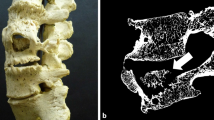Abstract
Bone from six patients with hypophosphataemic rickets resistant to vitamin D therapy was studied by scanning electron microscopy [SEM] in conjunction with light microscopy and microradiography of ground sections, and Schmorl-stained decalcified sections. SEM showed fractured surfaces to be more torn than normal bone. Cut surfaces showed more details of lamellae, due to drying, than normal bone. The circumlacunar, hypomineralized zones found in this disease, which are characteristically polarized towards the nearest free bone surface, were shown to consist of unfused, mineral particle clusters typical of those seen at the mineralizing front. The mineralizing fronts exposed by NaOCl treatment differed from those of normal bone in being spread through a greater number of lamellae in depth. An hypothesis is offered explaining the distribution of the circumlacunar hypomineralized zones in terms of an osteocytic negative or inhibitory influence on mineralization. It is possible that osteocytes may always in part retard mineralization of the matrix nearest to them, and that this becomes apparent in hypophosphataemic rickets because of some other factor which causes a general reduction in the level of mineralization.
Résumé
L’os de six patients, atteints de rachitisme hypophosphatémiques, résistant au traitement à la vitamine D, est étudié par microscopie électronique à balayage (SEM), ainsi que par microscopie optique et microradiographie de coupes par usure, et sur des coupes décalcifiées, soumis à la coloration de Schmorl. Le SEM montre que les surfaces de fractures sont moins nettes que dans l’os normal. Les surfaces coupées présentent plus de détails structuraux des lamelles, par suite de la dessication que dans l’os normal. Les zones périlacunaires hypominéralisées, observées dans cette maladie, qui sont situées, de façon caractéristique, vers la surface osseuse la plus proche, sont constituées d’agrégats de particules minérales, non fusionnées, identiques à celles que l’on observe au niveau des fronts de minéralisation. Ces derniers, traités par du NaOCl, diffèrent de ceux de l’os normal par le fait qu’ils s’étendent sur un plus grand nombre de lamelles en profondeur. La répartition des zones périlacunaires hypominéralisées pourrait être expliquée par une action négative ou inhibitrice des ostéocytes sur la minéralisation. Il est possible que les ostéocytes puissent retarder partiellement la minéralisation de la matrice adjacente et que cette influence devient apparente dans ce type de rachitisme par suite d’un autre facteur surajouté provoquant un ralentissement général de la minéralisation.
Zusammenfassung
Die Knochen von sechs Patienten mit Vitamin D-resistenter hypophosphatämischer Rachitis wurden untersucht. Knochenschliffe und Schmorl-gefärbte entkalkte Schnitte wurden mittels Rasterelektronen-Mikroskopie (REM), Lichtmikroskopie und Mikroradiographie studiert. REM zeigte, daß Bruchflächen unregelmäßiger waren als normaler Knochen. Angeschliffene Flächen zeigten infolge Austrocknung die Lamellen in größerem Detail als normaler Knochen. Die perilacunären, hypomineralisierten Zonen, die in dieser Krankheit gefunden werden und die charakteristisch auf die nächstliegende freie Knochenoberfläche polarisiert sind, bestanden aus isolierten Kristallhäufchen, wie sie für die Mineralisationsfront typisch sind. Die Mineralisationsfronten, welche durch NaOCl-Behandlung hervorgehoben wurden, unterschieden sich dadurch von denjenigen des normalen Knochens, daß sie in einer größeren Anzahl von Lamellen in die Tiefe zu finden waren. Eine Hypothese wird dargelegt, welche die perilacunären hypomineralisierten Zonen im Sinne eines osteocytischen negativen oder hemmenden Einflusses auf die Mineralisation erklärt. Es ist möglich, daß die Osteocyten immer die Mineralisation der ihnen am nächsten gelegenen Matrix teilweise verlangsamen und daß dies bei der hypophosphatämischen Rachitis zum Vorschein kommt, da ein anderer Faktor einen allgemeinen Rückgang des Mineralisationsniveaus hervorruft.
Similar content being viewed by others
References
Adams, P.H., Jowsey, J.: Sodium fluoride in the treatment of osteoporosis and other bone diseases. Ann. intern. Med.63, 1151–1154 (1965).
Boyde, A.: Scanning electron microscope studies of bone, chap. 8, p. 259–310 in: Bourne, G.H. (ed.), The biochemistry and physiology of Bone, vol. 1, New York: Academic Press 1972.
Boyde, A., Hobdell, M.H.: Scanning electron microscopy of primary membrane bone. Z. Zellforsch.99, 98–108 (1969).
Burkhart, J.M., Jowsey, J.: Morphological evidence of osteomalacia in dogs. Mayo Clin. Proc.41, 663–667 (1966).
Jones, S.J., Boyde, A.: Experimental studies on the interpretation of bone surfaces studied with the SEM, p. 193–200 in: Om Johari (ed.), Scanning electron microscopy. Chicago Illinois U.S.A.: IIT Research Institute 1970.
Steendijk, R., Hooff, A. van den, Nielsen, H.K.L., Jowsey, J.: Lesion of the bone matrix in vitamin D-resistant rickets. Nature (Lond.)207, 426–427 (1965).
Steendijk, R., Jowsey, J., Hooff, A. van den, Nielsen, H.K.L.: Microradiographic and histological observations in primary vitamin D-resistant rickets, p. 175–178 in: H. Fleisch, H.J.J. Blackwood and M. Owen (eds.), Third European Symposium on Calcified Tissues. Berlin-Heidelberg-New York: Springer 1966.
Steendijk, R., Jowsey, J., Hooff, A. van den, Nielsen, H.K.L.: Microradiographic and histological studies in vitamin D-resistant rickets, p. 127–135 in: D.J. Hioco (ed.) L’Osteomalacie. Paris: Masson 1967.
Author information
Authors and Affiliations
Rights and permissions
About this article
Cite this article
Steendijk, R., Boyde, A. Scanning electron microscopic observations on bone from patients with hypophosphataemic (vitamin D resistant) rickets. Calc. Tis Res. 11, 242–250 (1973). https://doi.org/10.1007/BF02547223
Received:
Accepted:
Issue Date:
DOI: https://doi.org/10.1007/BF02547223




